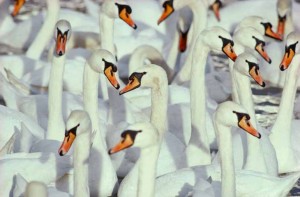Swanning About
Montrose Basin Nature Reserve is a great place to see large numbers of Mute Swans throughout the year. But this hasn’t always been the case, so why do they gather on the reserve in such large numbers now?
Traditionally the swans would only frequent the Basin in the summer months, using the Basin as a safe haven where they could moult their flight feathers whilst feeding on aquatic plants within the genus Zostera, commonly called eelgrasses. The abundance of eelgrass reduces in winter, with die-offs occurring, meaning the swans have lost their primary food source. For many years the swans frequented the harbour area during winter, attracted to the easy pickings provided by a local food factory, which dumped its waste into the water. However, in the late 1980’s changes were made to minimise this practice, meaning that the factory could only release small amounts of waste and only when the tide was on its way out. This helped to ensure that the food waste would be carried out to sea and dispersed much quicker. This in turn resulted in the swans staying in the Basin area to feed all year, even after the supplies of eelgrass had reduced in the autumn.
This change was initially offset by the fact that the swans had access to potato and carrot washings in October and November from a farm on the edge of the Basin. But the swans still needed to eat something between the months of December and April, when the eelgrass would re-grow. At the same time farming patterns were beginning to change in an effort to boost incomes, with more crops such as oil-seed rape and winter wheat being planted over the winter. The inevitable happened and the swans moved onto the fields and began eating the crops. This coupled with new restrictions on the practice of discarding the potato and carrot scraps into the Basin meant that the swans began grazing in the fields from October to May. This was, of course, detrimental to the farmers yields and a solution needed to be found.

For 10 years the swans were fed by hand with barley, wheat and vegetable waste to try and draw them off the crops, but this method had varying degrees of success. The farmers then tried tipping barley out onto the edge of the Basin, but in addition to the swans this just served to provide a free meal for the large population of ducks, and after the barley was quickly finished the swans would simply return to the crops.
These problems lead to a new relationship developing between the reserve and the farmers, with 2 seats being made on the reserve management committee in 1998 to enable the farmers to be represented. This led to a project being set up and new initiatives being trialled, the main one being to allow the swans to graze freely on a sacrificial field throughout the winter. This may not sound like the best solution for the farmers, but compensation was to be paid for the resulting loss in crop yield from this field. Near the sacrificial field there was also an allocated comparison field of the same crop, in which the swans were actively kept off of. At the end of the season, when the crops came to harvest, the yields of both fields were weighed and compared, with the difference assumed to be as a result of damage from the swans. The resulting loss in income was then compensated by all those in the basin management programme.
In 2002 this demonstration project ended and the farmers and committee had to revert back to the method of tipping out barley at the edge of the Basin. Alongside this, work was done by members of staff to actively discourage the swans from grazing on the crop fields. One side effect from this method was the increase in number of Whooper Swans that were stopping at the Basin over the winter period to feed on the barley. Traditionally only a handful of Whooper Swans could be found on the Basin in the winter, but attracted by the free meal, these numbers soon increased and between 150 and 250 could be found on the reserve in the winter months. This meant that the Whooper Swans had began to use the Basin instead of other local nature reserves and over 1% of the UK population could be found here, making it a nationally important site for them. To help overcome this problem, it was decided that in 2012 there would no longer be any barley left out for the swans and the oly deterrence method used would be the work done by a member of staff who would discourage the swans from feeding on the fields. This has led to the Whooper Swans again reducing in number whilst at the same time ensuring the damage caused by the Mute Swans has been kept to a minimum.
Craig Shepherd,
Visitor Centre Assistant Manager.
Help protect Scotland’s wildlife
Our work to save Scotland’s wildlife is made possible thanks to the generosity of our members and supporters.
Join today from just £3 a month to help protect the species you love.
Preface
Montrose Basin Nature Reserve is a great place to see large numbers of Mute Swans throughout the year. But this hasn’t always been the case, so why do they gather …
